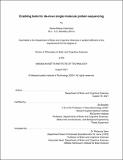Enabling tools for de-novo single molecule protein sequencing
Author(s)
Estandian, Daniel Masao
DownloadThesis PDF (5.409Mb)
Advisor
Boyden, Ed
Terms of use
Metadata
Show full item recordAbstract
Proteins are the functional units of all living cells and the subsequent product of many genes. Subtle changes in protein structure and function can cause deleterious effects and, in cases of critical protein units, precipitate large-scale biological dysfunction. Amino acids are the fundamental building block of proteins, ultimately determining protein folding structure and functionality. As such, the ability to detect and analyze low abundance proteins at amino acid resolution can greatly accelerate research into protein function and biology. However, in stark contrast to the relative success of DNA sequencing technologies, there is currently no efficient and cost-effective strategy that is able to adequately achieve single molecule protein sequencing at amino acid resolution. The critical hurdle in protein sequencing is overcoming the intramolecular interactions between amino acids that compete, prevent access, or interfere with the function of reagents that can detect amino acid side chains. Current solutions involve denaturation agents that are transient, harsh, and can compromise the integrity of amino acid identification tools. In addition, these methods only solve some of the intramolecular interactions of proteins. In this thesis, I present a novel and complete intramolecular disruption strategy, as well as the rational design of a molecule called ClickP. Together, these two elements enable single molecule protein sequencing by disrupting proteins’ internal intramolecular environment and physically isolating terminal amino acids, which in turn, will allow detection tools to identify individual amino acids with specificity and sensitivity. Progress in developing this technology has the potential to revolutionize proteomics by enabling single molecule resolution protein analysis to become feasible, inexpensive, and routine.
Date issued
2021-09Department
Massachusetts Institute of Technology. Department of Brain and Cognitive SciencesPublisher
Massachusetts Institute of Technology